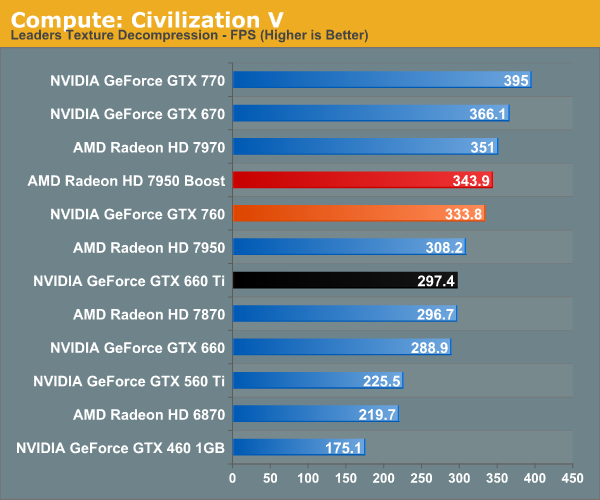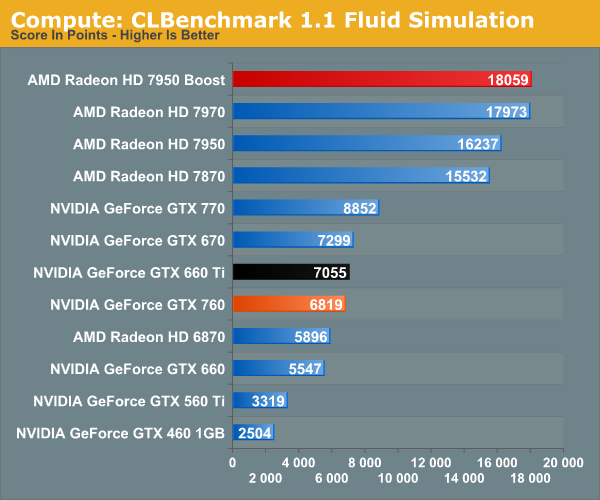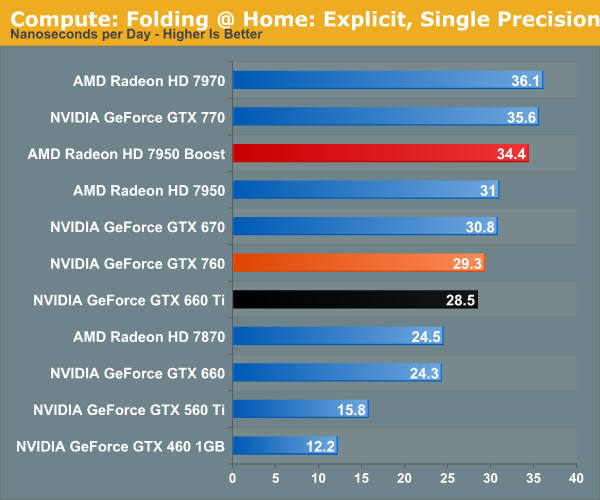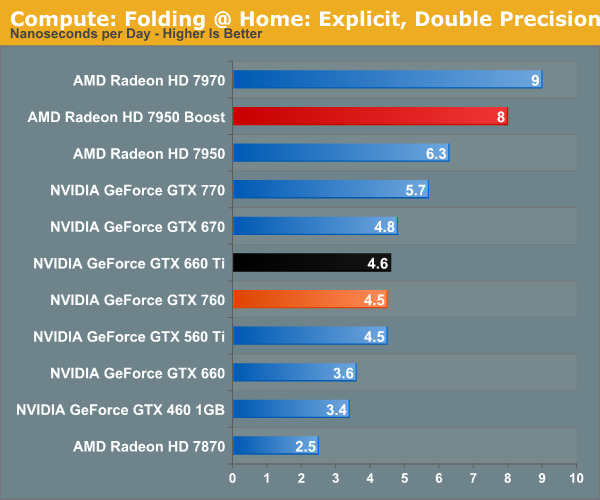NVIDIA GeForce GTX 760 Review: The New Enthusiast Kepler
by Ryan Smith on June 25, 2013 9:00 AM ESTCompute
Jumping into compute, we aren’t expecting too much here. Outside of DirectCompute GK104 is generally a poor compute GPU, and the loss of an SMX relative to the GTX 660 Ti isn’t doing the GTX 760 any favors here. By all appearances the GTX 760 is even more of a pure gaming card than the GTX 660 Ti was.
As always we'll start with our DirectCompute game example, Civilization V, which uses DirectCompute to decompress textures on the fly. Civ V includes a sub-benchmark that exclusively tests the speed of their texture decompression algorithm by repeatedly decompressing the textures required for one of the game’s leader scenes. While DirectCompute is used in many games, this is one of the only games with a benchmark that can isolate the use of DirectCompute and its resulting performance.

Civilization V once more validates that NVIDIA’s DirectCompute performance is generally up to snuff in this case. The fact that the GTX 760 is ahead of the GTX 660 Ti by any degree took us by surprise at first, but we’re likely looking at a scenario where the wider memory bus and/or larger L2 cache of GTX 760 offset some of the general compute gap.
Our next benchmark is LuxMark2.0, the official benchmark of SmallLuxGPU 2.0. SmallLuxGPU is an OpenCL accelerated ray tracer that is part of the larger LuxRender suite. Ray tracing has become a stronghold for GPUs in recent years as ray tracing maps well to GPU pipelines, allowing artists to render scenes much more quickly than with CPUs alone.

Luxmark is entirely about compute performance, and as a result this is an exceptionally poor showing for the GTX 760, with the GTX 660 Ti having no trouble besting it.
Our 3rd benchmark set comes from CLBenchmark 1.1. CLBenchmark contains a number of subtests; we’re focusing on the most practical of them, the computer vision test and the fluid simulation test. The former being a useful proxy for computer imaging tasks where systems are required to parse images and identify features (e.g. humans), while fluid simulations are common in professional graphics work and games alike.


Breaking down our CLBenchmark results, the computer vision test has frequently favored raw clockspeed over total shader throughput, which gives the GTX 760 an interesting advantage here. It’s capable of easily leaving the GTX 660 Ti in the dust and even edge out the GTX 670. Of course this is still less than 2/3rds the performance of even the slowest AMD GCN card, reflecting AMD’s superior computer performance.
The fluid simulation is especially brutal in that regard. Once again shifting back to an almost complete reliance on shader throughput, GTX 760 slightly trails GTX 660 Ti, never mind the nearly three-fold difference between it and the 7950B.
Moving on, our 4th compute benchmark is FAHBench, the official Folding @ Home benchmark. Folding @ Home is the popular Stanford-backed research and distributed computing initiative that has work distributed to millions of volunteer computers over the internet, each of which is responsible for a tiny slice of a protein folding simulation. FAHBench can test both single precision and double precision floating point performance, with single precision being the most useful metric for most consumer cards due to their low double precision performance. Each precision has two modes, explicit and implicit, the difference being whether water atoms are included in the simulation, which adds quite a bit of work and overhead. This is another OpenCL test, as Folding @ Home has moved exclusively to OpenCL this year with FAHCore 17.


Unlike some of our other compute benchmarks, the GTX 760 doesn’t fare too poorly here when it comes to single precision. However it’s still notably behind the 7950B in this case. And with double precision it’s no contest.
Wrapping things up, our final compute benchmark is an in-house project developed by our very own Dr. Ian Cutress. SystemCompute is our first C++ AMP benchmark, utilizing Microsoft’s simple C++ extensions to allow the easy use of GPU computing in C++ programs. SystemCompute in turn is a collection of benchmarks for several different fundamental compute algorithms, as described in this previous article, with the final score represented in points. DirectCompute is the compute backend for C++ AMP on Windows, so this forms our other DirectCompute test.

As another compute throughput bound benchmark, the GTX 760 is essentially tied with the GTX 660 Ti. This benchmark is somewhat memory bandwidth sensitive, which is why the GTX 760 doesn’t outright lose to the GTX 660 Ti here.










110 Comments
View All Comments
JlHADJOE - Wednesday, June 26, 2013 - link
The GTX670 still looks like a better configuration. Having two disabled SMs and trying to make up the performance difference with clock speed means the 760 is slightly slower than the 670, all the while using more power. There's likely less performance to be gained from overclocking too.I can only guess that they are heavily binning GK104s and every good chip is going into the 770, and with the product line being cut down the 760 has to accept all the rejects so its spec calls for up to two non-functional SMs.
intercede007 - Wednesday, June 26, 2013 - link
EVGA lists a 4GB part (04G-P4-2766-KR) and an overclocked 4GB part (04G-P4-2768-KR ). The review only covers the reference 2GB design.Is there any reason to think the additional 2GB of memory at the same clock rate as a 2GB part will be worth the additional cost? The price difference appears to be $40.
monkeydude66 - Wednesday, June 26, 2013 - link
Thank you so much for including GTX 460, 560 Ti in the review! Anandtech delivers once again. I find it absolutely ridiculous when major GPU Review sites only compare new GPUs to the last generation or completely unrelated GPUs unworthy of comparing to to a mainstream card. Good work.mapesdhs - Wednesday, June 26, 2013 - link
I'll probably get a 700 series card next month, in which case I'll start adding data to my
site, which already has a lot of 460 info. Do you have a 460? (or two?) If so, which models?
Ian.
monkeydude66 - Wednesday, June 26, 2013 - link
Yeah, I have the Gigabyte GV-N460OC-1GI with 1GB. Planing to upgrade to GTX760 after seeing the +100% performance change.mapesdhs - Monday, July 1, 2013 - link
So is your 460 the version that has a 715MHz core clock? In that case yes indeed, the 760
should give you a major performance bump. Btw, what CPU/mbd do you have? CPU needs
to be reasonably decent to feed something like a 760.
Ian.
SilverBack - Wednesday, June 26, 2013 - link
Ryan the GTX 760 4 gb is out can we get a comparison?slickr - Wednesday, June 26, 2013 - link
Too expensive for me, $250 is still quite a lot, especially since the GTX 460 1GB was $200, then the GTX 560 was $200.I'm going to wait for competition from AMD and see if they offer better value for money.
rs2 - Wednesday, June 26, 2013 - link
How did the 660Ti score so highly on the Crysis 3 benchmark @ 2560x1440? Seems like an invalid result?Ryan Smith - Thursday, June 27, 2013 - link
Good catch. That was a data entry error; that was supposed to be 34, not 44. It has been corrected. Thanks.